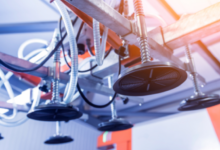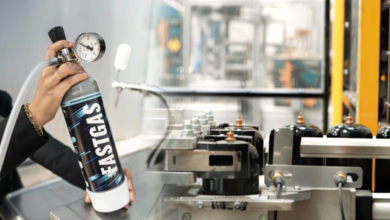Cobot Guide for Smarter and More Efficient Automation

In today’s fast-paced manufacturing world, businesses are seeking solutions that improve productivity without compromising safety, and cobots are leading that change. These collaborative robots work alongside people, handling repetitive, precise, or physically demanding tasks easily.
Adding cobots to production lines helps improve workflow, reduce downtime, and boost product quality. In this cobot guide for smarter and more efficient automation, we will explore how cobots work, their key benefits, and the best ways to implement them for maximum impact.
What Is a Cobot?
A cobot, or collaborative robot, is a robot made to work safely alongside humans, without needing protective barriers like traditional industrial robots. Regular robots often work in separate areas because they move quickly and can be dangerous. Cobots have sensors, cameras, and smart controls that let them sense people nearby and avoid accidents.
Cobots take care of repetitive, boring, or physically hard tasks so that people can focus on more important or creative work, making the workplace safer and more productive.
How Cobots Work
- Sensors for Safety and Interaction
Cobots have sensors such as force sensors, cameras, and proximity detectors. These help them detect their surroundings, notice people nearby, and act safely.
- Intuitive Programming Interfaces
Cobots are easy to program. Operators can teach tasks by hand-guiding the robot or using tablet-based interfaces. No advanced coding is needed, making setup quick and flexible.
- Collaborative Operation Modes
Cobots can work safely in different modes:
- Hand Guiding: Humans guide the cobot to teach tasks.
- Speed & Separation Monitoring: The cobot slows down or stops if a person enters a safety zone.
- Power & Force Limiting: The cobot limits its force to avoid injury.
- Monitored Stop: The cobot stops and waits for human intervention if needed.
- Integration with Existing Systems
Cobots can be easily added to existing production lines. They use tools to assemble, package, and check products. This makes them great for small and medium businesses that want automation without changing everything.
Key Components of a Cobot
- Robotic Arm: Moves and positions the cobot.
- End-Effector: Tool attached to the arm (e.g., gripper, welder).
- Sensors: Detect the environment and human interaction.
- Controller: Processes sensor data and controls the cobot.
- User Interface: Let’s operators program and monitor the cobot.
Cobots make production safer, more flexible, and easier to manage. They work directly with humans, adapt to different tasks, and help modern manufacturing become more efficient.
Benefits of Using Cobots
Collaborative robots, or cobots, are transforming modern factories by making production more efficient, safer, and flexible. Here’s how they add value:
- Higher Productivity and Efficiency
Cobots take over repetitive or physically demanding tasks, freeing human workers to focus on more complex and value-added activities. They can operate continuously without fatigue, increasing production speed and reducing cycle times. For instance, at Ford, cobots assist in bolting car parts, reducing worker exhaustion and boosting overall efficiency.
- Improved Product Quality and Consistency
Cobots deliver precise, repeatable performance, minimizing human errors and ensuring consistent product quality. Equipped with advanced sensors and cameras, they can inspect parts, detect defects, and maintain high standards across production runs.
- Safer Workplaces
Cobots are designed with safety features like force sensors and cameras. These let them sense when people are nearby and adjust their movements to avoid accidents, so they can work safely alongside employees without safety cages or barriers.
- Reduced Operator Fatigue
Cobots take over repetitive and physically demanding tasks, reducing both the physical strain and mental stress on workers. This helps create a healthier and more satisfied workforce.
- Flexibility for Small-Batch and Custom Production
Cobots can be easily reprogrammed to handle different tasks, making them ideal for small-batch or customized production runs. They enable manufacturers to quickly adapt to changing product demands without long downtime or complicated setup.
Cobots enhance manufacturing by boosting efficiency, maintaining consistent quality, improving safety, reducing worker fatigue, and providing flexible production capabilities. By combining human intelligence with robotic precision, cobots help create smarter, safer, and more adaptable manufacturing environments.
Best Practices for Implementing Cobots
Using collaborative robots, or cobots, can make manufacturing more productive, safer, and flexible. To get the most out of cobots, follow these best practices:
- Figure Out Which Tasks Can Be Automated
Identify tasks in your operations that are repetitive, dangerous, or physically difficult for workers. Cobots can take over these jobs, allowing employees to focus on more complex work. Analyzing your workflow can also help spot areas that can be improved.
- Set Clear Goals and Measure Success
Decide what you want to achieve with cobots, like increasing production, improving quality, reducing lead times, or making the workplace safer. Make these goals specific and measurable, and track them regularly to see how well the cobots are performing.
- Choose the Right Cobot for the Job
Select a cobot that suits the task you need it to do. Check its lifting capacity, reach, precision, and speed to make sure it can handle the work efficiently.
- Ensure Safety and Follow Standards
Look around the workspace for any dangers and take safety steps. Make sure the cobot doesn’t push too hard, moves at a safe speed, and can sense people nearby to avoid accidents.
- Get Employees Involved
Bring employees into the process early. Teach them how to work safely with cobots and let them help with setup and programming. This reduces resistance and makes it easier to integrate cobots into the workplace.
- Start Small with Pilot Projects
Try using cobots on just one task at first. This helps you see how well they work, identify any problems, and fix them before using cobots for the entire production line.
- Plan for Maintenance and Support
Set up regular maintenance and software updates to keep cobots running smoothly. Have a support team ready to handle issues quickly to avoid production downtime.
- Monitor Performance and Keep Improving
After cobots are in use, track their performance and compare it to your goals. Use this information to improve processes and explore more automation opportunities.
By following these steps, manufacturers can successfully bring cobots into their operations, improving efficiency, safety, and flexibility in the workplace.
A Wide Range of Applications for Cobots
Cobots are flexible and reliable robots that can be used in many industries. They are precise and consistent, making them very useful for modern manufacturing and production.
- Machine Tending and Assembly
Cobots can put materials into and take them out of machines like CNC machines, presses, or injection molding machines. This helps work get done faster and keeps workers safe from dangerous areas. They are also very good at putting together products like electronics, car parts, or medical devices accurately and reliably.
- Quality Inspection and Material Handling
Cobots can check products for defects and ensure they meet quality standards using built-in cameras and vision systems. In warehouses, cobots handle packaging, sorting, and moving materials, making work easier for employees and speeding up production.





